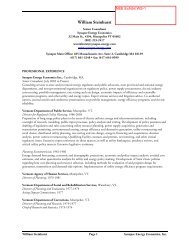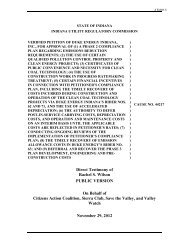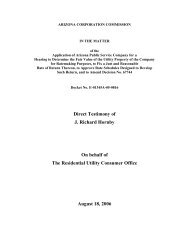Best Practices in Energy Efficiency Program Screening - Synapse ...
Best Practices in Energy Efficiency Program Screening - Synapse ...
Best Practices in Energy Efficiency Program Screening - Synapse ...
You also want an ePaper? Increase the reach of your titles
YUMPU automatically turns print PDFs into web optimized ePapers that Google loves.
To address this concern, we recommend that the PAC test be applied to the portfolio of<br />
efficiency programs, to ensure that the entire package of programs will result <strong>in</strong> a net<br />
reduction <strong>in</strong> revenue requirements and a net reduction <strong>in</strong> costs to utility customers.<br />
Under this approach, either the Societal Cost test or the TRC test would be the primary<br />
test for screen<strong>in</strong>g each energy efficiency program. <strong>Program</strong>s that do not pass the<br />
primary test would not be considered cost-effective. Then the PAC test would be applied<br />
to the portfolio of programs that do pass the primary test. If the portfolio of programs<br />
does not pass the PAC test, then one or more of the programs would need to be<br />
modified <strong>in</strong> such a way that the entire portfolio eventually passes the PAC test.<br />
This comb<strong>in</strong>ed program/portfolio screen<strong>in</strong>g approach should be simple to apply because<br />
it relies upon a s<strong>in</strong>gle, primary test (either the TRC test or the Societal test) for all of the<br />
detailed cost-effectiveness assessments, and the secondary test (the PAC test) is<br />
applied only once at the end of the assessment as a check on behalf of utility customers.<br />
Apply<strong>in</strong>g the tests this way allows for a balanc<strong>in</strong>g of the goal of achiev<strong>in</strong>g key public<br />
policy objectives, such as account<strong>in</strong>g for the full <strong>in</strong>cremental cost of the efficiency<br />
measure, account<strong>in</strong>g for other program impacts, and account<strong>in</strong>g for societal benefits,<br />
with the goal of ensur<strong>in</strong>g a net reduction <strong>in</strong> costs to customers. The application of the<br />
PAC test at the portfolio level also provides a clear <strong>in</strong>dication of the overall benefits to<br />
utility customers <strong>in</strong> terms of millions of dollars <strong>in</strong> net benefits.<br />
Illustrative Example<br />
Figure 2.1 illustrates program cost-effectiveness under the TRC the PAC tests, at the<br />
program and portfolio levels for our example New England utility. The TRC results<br />
below <strong>in</strong>clude the effect of OPIs.<br />
While the programs and portfolio exhibits strong cost-effectiveness, the figure<br />
demonstrates the pr<strong>in</strong>ciples described above. Specifically, the TRC can be applied at<br />
the program level to ensure that public policy goals are achieved, while the PAC can be<br />
applied at the portfolio to provide confidence that the overall energy efficiency <strong>in</strong>itiative<br />
will result <strong>in</strong> lower revenue requirements and lower bills on average for utility customers.<br />
| 20 <strong>Best</strong> <strong>Practices</strong> <strong>in</strong> <strong>Energy</strong> <strong>Efficiency</strong> <strong>Program</strong> Screen<strong>in</strong>g | www.nhpci.org







